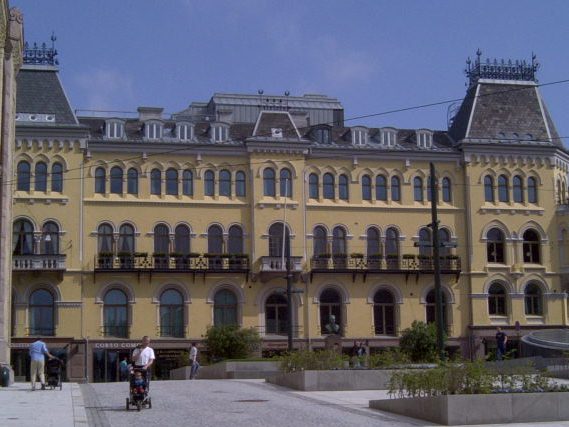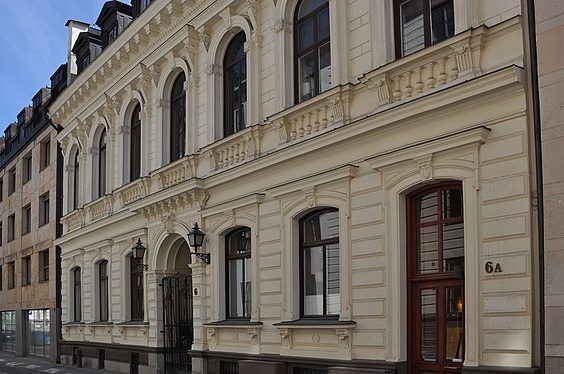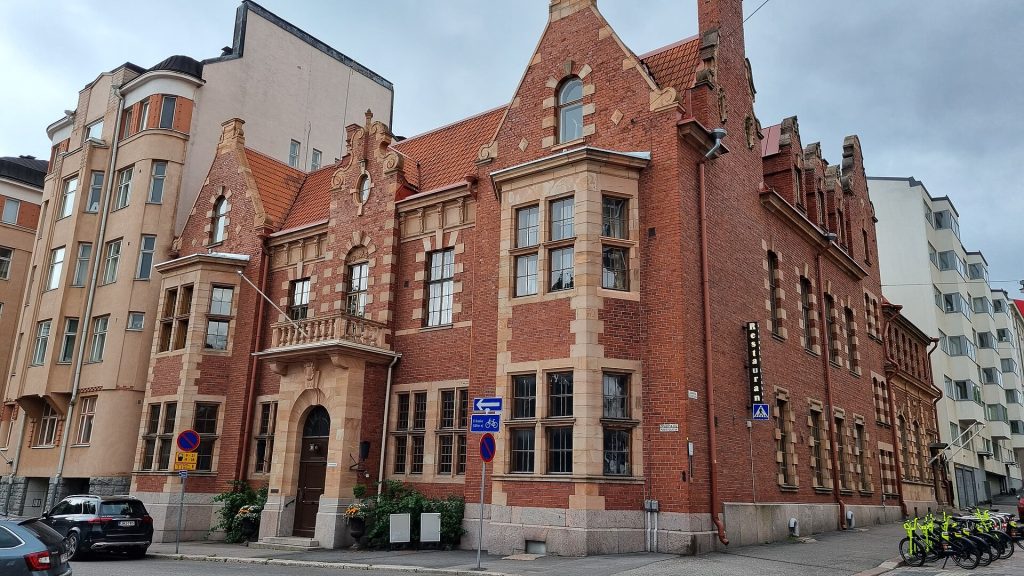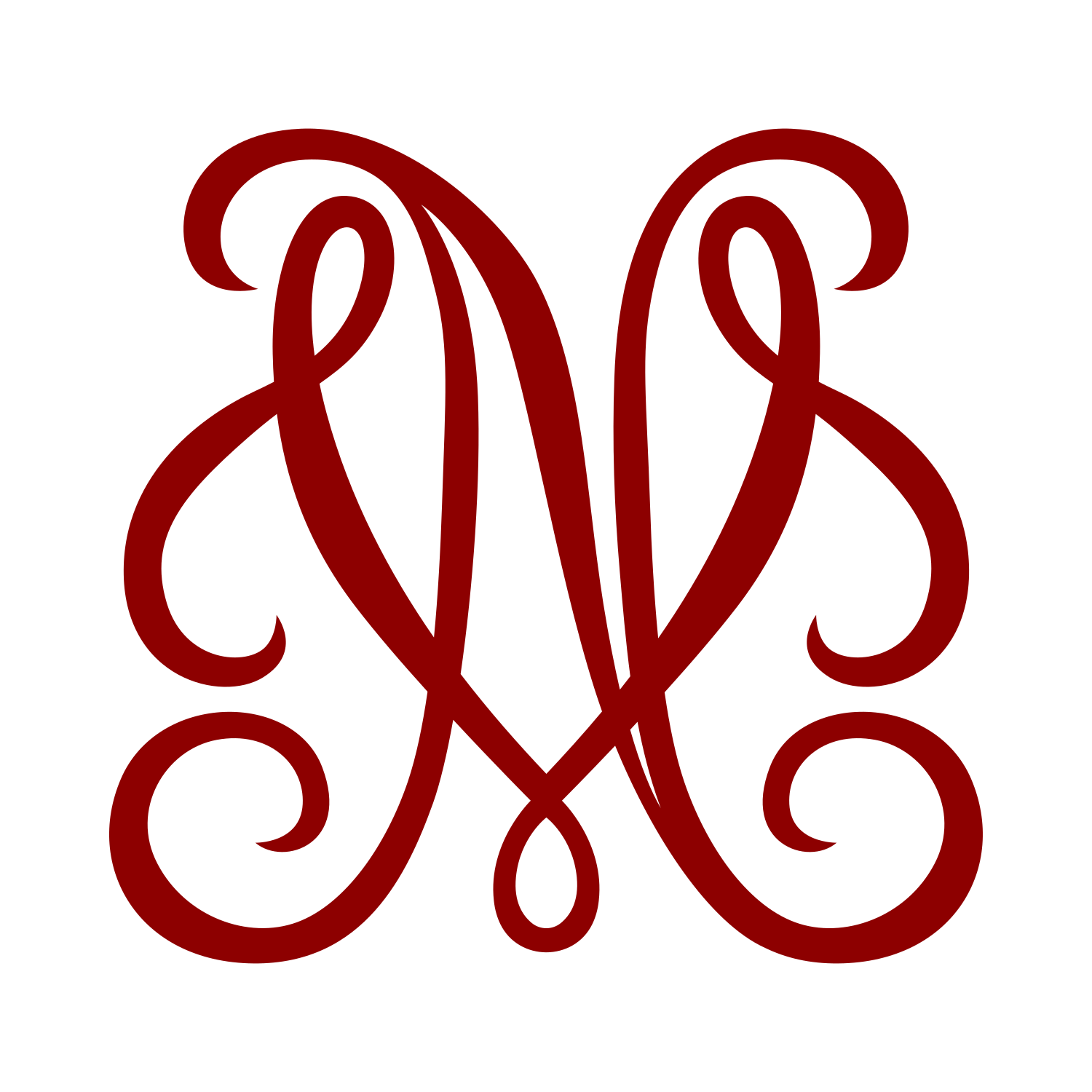The success of private members’ clubs in London during the eighteenth century led Nordic socialites seeking similar facilities closer to home. While the tradition of clubs may not be as deeply rooted in the Nordics as it is in countries like Great Britain, there are still a number of such exclusive establishments in the region. Here is a list of private members’ clubs in the Nordics – Sweden, Finland and Norway.
Royal Bachelors’ Club (1769)

The Royal Bachelors’ Club is the oldest active English-style gentlemen’s club in Sweden, located in Gothenburg. Founded in 1769, it ranks as the fourth-oldest club of its kind in the world. The club’s headquarters are situated in the Broström Villa at Skyttegatan 1, in the Lorensberg district of Gothenburg.
The club was established by a group with strong British and Scottish backgrounds. The first meeting took place on November 25, 1769. Among the founding members was William Chalmers, founder of Chalmers University of Technology. In 1787, the club was granted a royal privilege by King Gustav III, mediated by the royal secretary Claes Gartz, who became an honorary member.
The club has moved several times over its long history. Initially, it met at the Wilsonska House near Gustaf Adolf’s Square but moved in 1932 to Kungsportsavenyn 8. In 1969, it settled in its current location, the Broström Villa, which was designed by architect Arvid Bjerke.
At the time of writing this, the Royal Bachelors’ Club has 1159 members of which 253 are senior members
Visit the club’s website.
Norske Selksab (1772)

Founded in Copenhagen in 1772, Norske Selskab began as a gathering place for Norwegians living in the Danish-Norwegian capital. Its members were primarily students, young academics, and officers. The club’s shared interest in theater and literature united them, and within two years, it formally became Det Norske Literaire Selskab. The poets of the club, particularly Johan Herman Wessel, left lasting marks on both Norwegian and Danish literary history with their works blending both humor and seriousness.
Members regularly gathered for meals and cheerful socializing around a punch bowl, singing drinking songs about love, friendship, and their shared homeland, Norway. However, the club was also a venue for serious discussions on contemporary issues, serving as a vital meeting point for Norwegians in a foreign city.
The original club in Copenhagen remained active until 1813, when it gradually included both Norwegian and Danish members. With the establishment of a university in Norway, the club was dissolved, as there would no longer be new students from Norway coming to Copenhagen, eliminating the club’s core purpose.
In 1818, Norske Selskab was re-established in Christiania (now Oslo) by former members from Copenhagen who sought to revive the traditions in Norway’s capital. The new club differed significantly from its predecessor. Former students and lieutenants were now statesmen, judges, and generals.
After several relocations, the club found a permanent home in 1873 on the third floor of Akersgaten 18.
Since 1853, the structure of the club has remained largely unchanged. Membership is reserved for men. During the German occupation in World War II, the club’s activities were dramatically halted when the occupiers dissolved the society and confiscated its building.
Today, Norske Selskab continues to honor its 1772 origins, remaining free of political and economic interests. The club’s primary focus is to foster friendship and the joys that come with it.
Visit the club’s website.
Sällskapet (1800)

Sällskapet – literally “The Society” in Swedish – was founded on December 1, 1800. It was established as a result of the fact that, in addition to various private homes, there was a lack of premises where like-minded gentlemen could meet, socialize and make new acquaintances in an environment well suited to its purpose. The club’s first premises were rented in the Kirsteinska House in the old town of Stockholm. After almost 50 years in 1849 the club moved to the Bergstrahlska house also in the old town. In 1857 the Club rented rooms in the newly built Hotel Rydberg at Gustaf Adolfs Torg, opposite the Royal castle. The club had the entire second floor at its disposal. Since 1870, the club has had its premises in the current, purposely built clubhouse at Arsenalsgatan 7. It was designed by the famous architect Johan Fredrik Åbom, whose portrait hangs in the clubhouse below the grand staircase. The then undeveloped property, on an almost deserted Blasieholmen, was purchased and built by the prominent builder Johan Andersson, later purchased by Sällskapet. He is also represented by the original deed of transfer of the property, which hangs in the library. Over the years, several books in Swedish about Sällskapet’s history and clubhouse have been published.
Since its founding, Sällskapet has been owned and managed by its members. The purpose remains unchanged to offer the opportunity for socializing in a friendly, dignified and warm home-like environment for the members and where applicable, with invited guests. The club owns one of Sweden’s largest private libraries, where books and journals are regularly acquired and updated. In addition to their own socializing and access to lunch and dinner, there is an extensive programme of activities for special interest groups, where lecturers are invited to a combination of meal and lectures in widely different areas. Each year, about a hundred activities are carried out, which range from a handful, to just over a hundred people. The club is open to both women and men, but since its founding with only male members, reflecting both the Club’s traditions and respect for them. Sällskapet’s dress-code is classic well-dressed in accordance with the style the members of the club wish to keep in their own clubhouse.
The purpose of the club from December 1, 1800 is unchanged. Sällskapet remains a place where its members and guests socialise, enrich their knowledge and enjoy.
Visit the club’s website.
Militärsällskapet (1852)

Founded in 1852, the Military Society of Stockholm was established to offer a welcoming space where military officers could gather, converse, and deepen their understanding of both military matters and the wider world. Over the years, the club has maintained its commitment to providing a home away from home for its members, including military personnel, royalty, and distinguished guests.
From its early days, the Military Society was an exclusive gathering spot for officers from the Army, Navy, and General Staff. Over time, it became a prominent social hub for military officers in Stockholm. Its longstanding connection to Swedish royalty, including King Oscar II and King Christian IX of Denmark, further elevated its prestige.
In 1908, Queen Victoria of Sweden took the initiative to address the growing need for accommodation among navy officers stationed in Stockholm. The Queen established a hotel known as “Queen Victoria’s Naval Home” — a refuge offering affordable lodging. Located just across the water from the Royal Castle, this hotel continues to serve Military Society members today, providing them with high-quality accommodations at reasonable rates.
As the Royal Swedish Air Force was established in 1926, membership in the Military Society expanded to include officers from this new branch. In 1985, with the integration of female officers into the Swedish Armed Forces, the club opened its doors to female members, reflecting its progressive ethos. Today, membership is available to all Swedish military personnel of rank OF-1 or higher, as well as senior officials from the Ministry of Defence, Ministry for Foreign Affairs, and Swedish Defence Industry.
The club’s facilities, located near the Armed Forces Headquarters on Stockholm’s fashionable Valhallavägen boulevard, provide members with a refined space for socializing, dining, and conducting both personal and business meetings. Members can enjoy lunch in the elegant dining halls, unwind in the Ulinders Bar, or relax in the club’s library. Although the club does not offer dining service every evening, weekly evening events create an atmosphere of camaraderie and connection.
The Military Society of Stockholm is part of an extensive network of affiliated clubs, offering its members reciprocal benefits when traveling abroad. Whether in Stockholm or abroad, members can enjoy the same privileges and connections within the broader community of military and social clubs.
Visit the club’s website.
Sällskapet (1874)

Nya Sällskapet was founded in Stockholm in 1874 with the purpose of “providing an opportunity for social interaction within a closed circle.” Initially, membership was capped at 100 members, excluding accredited foreign ministers. Since 1992, the membership limit has been set at 400 members. To join, an applicant requires a written proposal from two current members who must personally know the candidate and have been members for at least two years.
The club traces its origins back to 1850s Stockholm, when a small group of senior officials and notable individuals began meeting informally to discuss various topics, play cards, and engage in billiards. These gatherings were casual and, over time, the group diminished. Eventually, some members decided to collaborate with individuals in parliament to establish a smaller club, distinct from the well-established gentlemen’s club “Sällskapet,” which had been in operation since 1800.
In November 1873, the royal court marshal Baron Knut Åkerhielm, Major Count Axel von Rosen, Court of Appeal judge Otto Forssell, Chamberlain Baron Claës von Mecklenburg, and Chamberlain Count Nils Gyldenstolpe invited 42 gentlemen from Stockholm to join a new, smaller gentlemen’s club. Invitations were also sent to 31 gentlemen from other parts of Sweden, who were thought to be interested in joining the club. The club was then established on January 18, 1874, in a rented venue at Gustav Adolfs Torg 12. In the following years, it met at Hotel Rydberg and later moved to the Gustavian Opera House in the mid-1870s.
The idea of owning a property was soon proposed, and in 1882, a company was formed to fund the construction of a new building. Count Carl von Platen purchased a plot of land, and Robert Sager, chairman of the club’s building committee, oversaw the project. The architectural design was entrusted to brothers Axel and Hjalmar Kumlien. On October 1, 1883, the club moved into its new headquarters at Västra Trädgårdsgatan 6 in the Royal Garden block.
Nya Sällskapet does not have its own website.
Svenska Klubben i Helsingfors (1880)

The history of Svenska Klubben (Swedish: The Swedish Club) in Helsinki dates back to September 26, 1880, and its roots are in earlier club activities, such as Borgerliga Klubben (Swedish: The Bourgeois Club) and Konversationsklubben (Swedish: Thehe Conversation Club), which had been active for most of the century. The origins of organized club life in Helsinki are linked to the period around 1814 during the Napoleonic Wars when interest in news was at its peak.
The driving force behind the founding of the club was Professor Axel Olof Freudenthal, who had been a prominent advocate for Swedish Finland during the rise of the Fennoman movement in the late 1850s. Freudenthal initiated the founding of Svenska Klubben in Helsinki in 1880, drawing together like-minded individuals from the university. He became the first president of the club and a central figure in the Swedish nationalist movement in Finland.
The club’s activities revolved around promoting the Swedish language, intellectual discussion, social gatherings, and cultural events in a private environment. In the early years, the club’s members could enjoy a range of newspapers and engage in cultural and political debates, leading to significant initiatives such as the founding of Nya Pressen and the Swedish Literature Society.
The club’s life was enriched with events such as annual Runeberg and Gustav Adolf celebrations, discussions, and leisure activities like billiards, chess, and card games. Over the years, the club had several locations, eventually settling at its current address in Kronohagen.
By the early 20th century, the club had grown significantly in membership, with over 600 members by 1919. The club’s welcoming atmosphere, with affordable prices and social engagement, attracted members during times of crisis, such as during the World War II era.
In the 1930s, the club began forming connections with other Swedish clubs across Finland and internationally, including the Royal Bachelors’ Club in Gothenburg and the East India Club in London. Later, in the 21st century, the club formed partnerships with several Nordic clubs, strengthening its international network.
The club’s influence continued to grow, with the establishment of a research scholarship to support scientific work. It was first awarded in 1948 and contributed significantly to the academic community in Finland.
Today, the club continues to be a center for intellectual exchange, social activities, and cultural engagement, maintaining a rich tradition of fellowship and intellectual discourse.
Visit the club’s website.
Svenska Klubben i Åbo (1889)

Svenska Klubben in Åbo was founded in 1889 as a subsidiary of the Svenska Bildningens Vänner (S.B.V.) association. Initially, it had its own board, event committee, and bylaws, as well as a rented club space. In 1944, the name was changed from S.B.V.’s Club to Svenska Klubben in Turku, and the Foundation for Åbo Akademi was named as a beneficiary in the event of the club’s dissolution, replacing the S.B.V. association, which had previously held this role.
Among the club’s founding members were its first chairman, Ernst Rönnbäck, the head editor of Åbo Underrättelser; Dr. Georg von Essen, who became the club’s first honorary member; Alexander Kumlin, a court assessor; Viktor Svehla, a trade school director; and Gustaf Cygnaeus, a secondary school teacher.
The club’s early regulations did not specify a clear purpose, but by 1920, its official bylaws stated that the club’s activities were centered around “social interaction and cultural activities.” Membership was open to Swedish-minded individuals who were nominated by existing members. If the board did not reach a unanimous decision on a candidate, the matter was decided by a ballot committee, which included the board and five club members chosen at the annual meeting. The last ballot took place in 1955.
The club’s first few decades were marked by several moves within central Turku. It began in the Town Hall, originally the Society House, opened in 1812. The club then relocated to the Theatre House, followed by moves to Köpmansgatan 7 near the Market Square, Slottsgatan 16 in 1909, and Slottsgatan 13 in 1913.
In 1925, the club moved across the street to the Swedish House (Svenska Gården), occupying the third floor with an entrance on Slottsgatan 10. By this time, the club had become a shareholder in Svenska Gården, a company formed through a merger. The club continued to acquire shares and, by 1937, held a majority stake in the splendid Renaissance-style building at the corner of Aura and Slottsgatan. The club expanded to the fourth floor in 1928 and moved to the fifth floor (formerly the attic) in May 1983. In the fall of 2009, the club also began using spaces facing Slottsgatan.
The building was completed in 1898 and designed by architect Fritiof Strandell, who created many distinguished buildings still standing in Turku. The building originally housed shops, offices, and private apartments. For decades, only one residential apartment remained, with the rest used for businesses or club facilities.
Visit the club’s website.
Helsingfors Börsklubb (1910)

Helsingfors Börsklubb (Helsinki Stock Exchange Club) was founded in February 1912, although its activities began in 1910. The club was established by the same parties responsible for founding the Helsinki Stock Exchange. It started operations in the Helsinki Stock Exchange building at Fabianinkatu 14, where it is still located today, on the fourth floor. The club follows the model of a traditional English-style social club, with its interior ordered from England. Its facilities include a lobby, large dining room, private rooms, a library, bar, billiard room, cigar lounge, and a balcony overlooking the courtyard. The club’s restaurant has received recognition from the Chaîne des Rôtisseurs, an international gastronomic society based in Paris. The club also organizes various special interest groups, including those focused on billiards, wine, automobiles, bridge, hunting, golf, boating, and literature. The club values traditional etiquette and maintains a strong social culture. Membership is granted once a year, with new applicants requiring two sponsors who must have been members for at least two years. The candidate must be someone who would actively use the club’s services, and existing members should benefit from their presence. Since 2019, the club has accepted both men and women as members.
Visit the club’s website.

